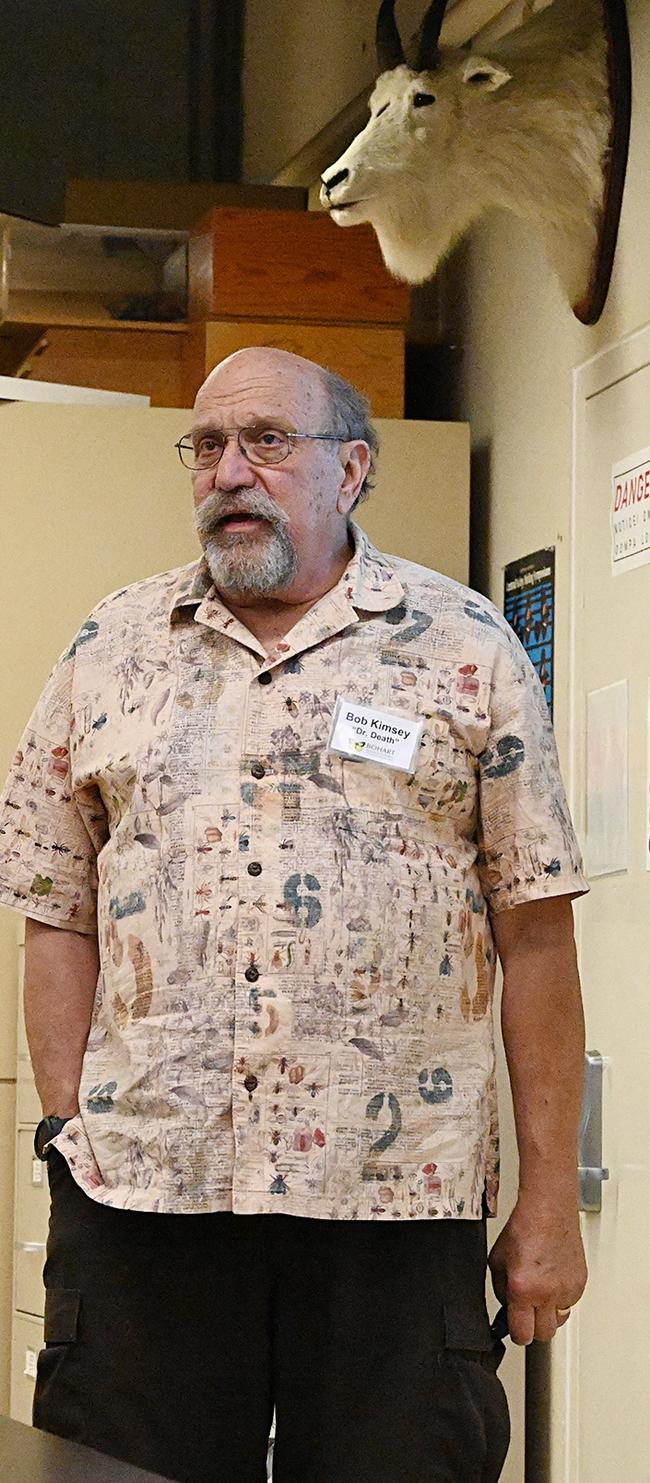
He told the villagers to line up in town square with their sickles. When they did, he immediately fingered the killer. The killer confessed.
How did Song Ci know? Because minute traces of blood left on the "cleaned" sickle drew a swarm of blow flies.
That was one of the stories that UC Davis forensic entomologist Robert "Bob" Kimsey of the Department of Entomology and Nematology recounted in his 45-minute talk during the Bohart Museum of Entomology open house on "Forensics and Insects."
Song Ci, also a judge, physician, anthropologist and writer, went on to author the book, Collected Cases of Injustice Rectified, containing the oldest known cases of forensic entomology.
In his presentation, Kimsey discussed the life cycle and development of blow flies and other insects. He is frequently called as a expert court witness at murder trials.
"Correct species identification is all important," said Kimsey, aka "Dr. Bob," in noting that different species have different development rates. He compared the life cycle of four species--Cochliomyia macellaria (secondary screwworm), Chrysoma rufifacies (a blow fly species), Phomia regina (a black blow fly), and Lucilia sericata (a common green bottle fly)--developing at a temperature of 27 Celsius. C. macellaria is the fastest and P. regina is the slowest, he said.
Kimsey also showed a chart illustrating the approximate age of a blow fly developing during a temperature of 72 degrees Fahrenheit. Another chart included information on the succession of arthropod taxa on carrion.
Following his talk, held in the nearby Museum of Wildlife and Fish Biology lecture room, Kimsey fielded questions in his "Dr. Death booth" in the Bohart Museum. He annually portrays Dr. Death at Briggs Hall during the annual campuswide UC Davis Picnic Day every April.
At the open house, the Bohart Museum displayed a number of species involved in forensic entomology, including
- Acalyptrate flies, numerous and diverse families, scavenging maggots
- Bluebottle flies, family Calliphoridae, scavenging maggots
- Green bottle flies, family Calliphoridae, scavenging maggots
- Large carrion, or burying beetles, family Silphidae
- Flesh flies, family Sarchophagidae, scavenging maggots
- Coffin flies, family Phoridae, scavenging maggots
- Clown or hister beetles, family Histeridae, predaceous beetles
- Red-legged ham beetle, family Cleridae, omnivorous predators that also scavenge
- Sap beetles, family Nitidulidae, "indirect" scavenge beetles
- Cockroaches, order Blattodea, scavenging larvae and adults
- Rove beetles, family Staphylinidae, predaceous beetles and their larvae
- Termites, infraorder Isoptera, scavengers for nitrogen
- Ants, family Formicidae, predators and scavengers
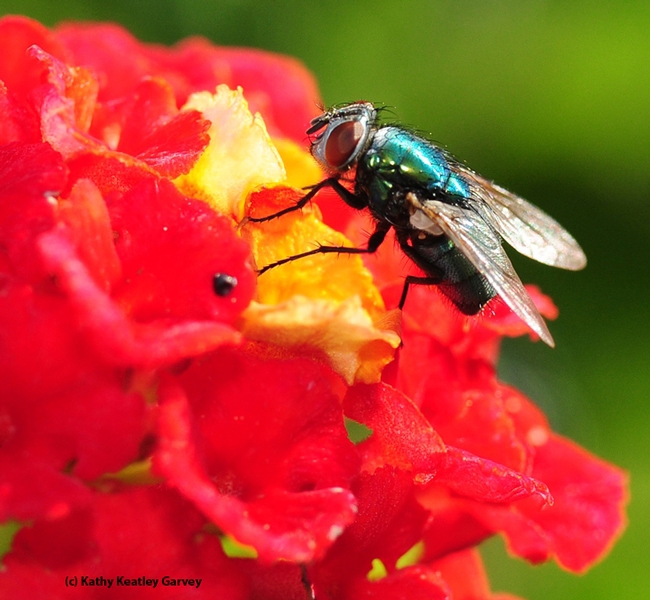
Ants: "Ants are a nightmare for the forensic entomologist! They are of little use as evidence as yet, but they can easily confound the development of vital evidence by establishing residency and defending the decedent from other scavengers, and further delay development of vital evidence by carrying off fly eggs and small maggots. Thus, they can delay progress of insect-mediated decomposition and feed vital evidence to their developing larval ants: the first, thus oldest and most important maggot cohorts (to the forensic entomologist)! They also ambush, kill and dismember female flies coming to the decedent to lay eggs."
Green Bottle Flies: "Green bottle flies are iridescent green in color. They belong to the genus Lucilia and comprise some of the most common flies with maggots that feed on carrion. A number of species, including the green bottle fly, Lucilia sericata, and the bronze bottle fly, Lucilia cuprina, have been introduced worldwide by human commerce, and the later, also known as the Australian sheep blow fly, commonly infests living sheep in Australia, causing enormous economic damage."
Termites: "In other parts of the world, insects exotic to what we in the temperate zones consider to be the standard groups associated with carrion, assist in the decomposition process. Termites in Central America exemplify such 'exotics' to decomposition, building mud casings over and defending carrion against all comers in an effort to garner nitrogenous materials to supplement their extremely nitrogen-poor diet."
Clown or Hister Beetles: "Distinctively shiny black and resembling a pill, these small to very small beetles feed on a great diversity of small arthropods found in carrion, including the smallest stages of maggots, fly eggs and scavenger or predaceous mites. Active at night, the numerous carrion-associated species appear in nearly all stages of decomposition, often specializing on prey found only in a particular stage.
Flesh Flies: "This very large family consists of large robust scavenger species and small species that parasitize other insects. The scavengers, Sarchophaga and Blaesozipha, frequently do not usually lay eggs but frequently deposit a small number of first-stage maggots on carrion, which puts their maggots at a distinct advantage over maggots of egg-laying species."
Cockroaches: "A number of cockroach species found around the house (peridomestic) will gnaw on the skin of decedents indoors during the early fresh stage of decomposition. They are well known to chew on the calluses, clean debris from under the fingernails and around the toes of sleeping sailors on ancient sailing ships right through to the current day. This kind of depredation occurs in circumstances of overwhelming cockroach infestations. In similar circumstances, they are also responsible for chewing on the ears and eyelashes of newborn infants in cases of child neglect."
The family art-and-crafts activity involved maggot-inspired art. Participants dipped maggots in non-toxic, water-based paint and guided them on white paper to create their masterpieces, suitable for framing or at least as conversation pieces. (Photos to appear in June 9th Bug Squad blog)
The next open house at the Bohart Museum is "Night at the Museum" (Moth Night) from 7 to 11 p.m. on Saturday, July 22. All open houses are free and family friendly, and parking, too, is free.
The Bohart Museum, directed by UC Davis distinguished professor Lynn Kimsey, houses a global collection of eight million insect specimens. It also maintains a live "petting zoo" (Madagascar hissing cockroaches, walking sticks, tarantulas and more) and an insect-themed gift shop, stocked with t-shirts, hoodies, jewelry, posters, books, pens and collecting equipment.
The Bohart Museum is located in Room 1124 of the Academic Surge Building, 455 Crocker Lane, UC Davis campus. The Bohart will be open to the public (walk-ins) only on Tuesdays from 2 to 5 p.m., this summer, starting June 13. This is due to the high number of outreach programs, summer camps, scheduled tours and unavailability of staff. More information is available on the website or by emailing bmuseum@ucdavis.edu.
Attached Images:
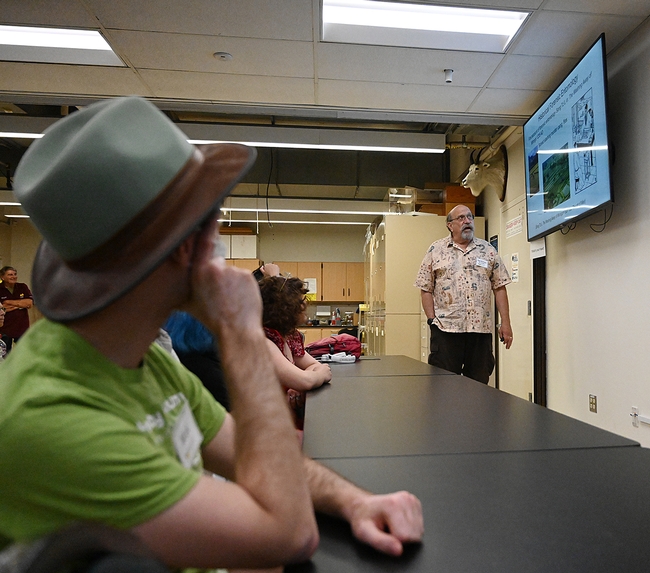
UC Davis forensic entomologist Bob Kimsey tracing the history of forensic entomology. (Photo by Kathy Keatley Garvey)
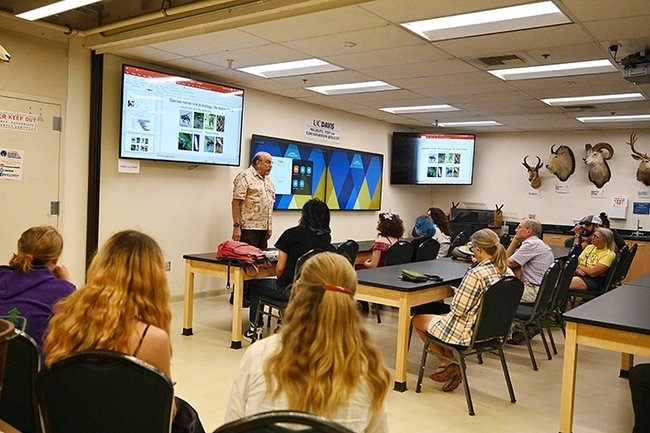
Forensic entomologist Bob Kimsey fields questions following his 45-minute talk. The Bohart Museum of Entomology's open house was themed "Forensics and Insects." (Photo by Kathy Keatley Garvey)
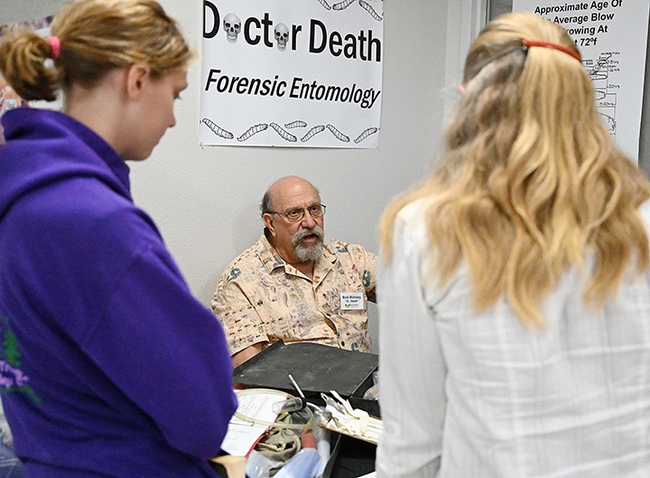
Forensic entomologist Bob Kimsey answering questions at his booth in the Bohart Museum of Entomology. (Photo by Kathy Keatley Garvey)